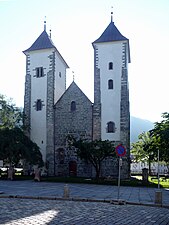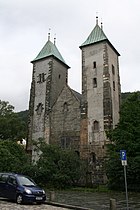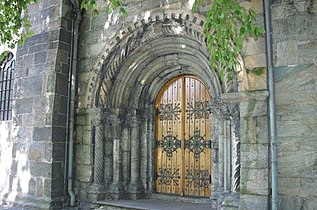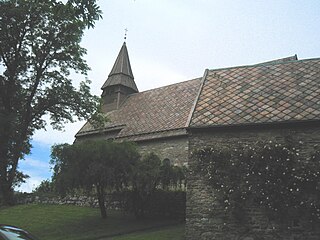
Fana Church is a parish church of the Church of Norway in Bergen Municipality in Vestland county, Norway. It is located in Fanahammeren, a village in the borough of Fana in the city of Bergen. It is one of the two churches for the Fana parish which is part of the Fana prosti (deanery) in the Diocese of Bjørgvin. The gray, stone church was built in a long church design in the year 1153 using plans drawn up by an unknown architect. The church seats about 450 people. The existing stone building celebrated its 850-year anniversary in 2003, but the church building history is long and complicated. Historians assert that the church has been rebuilt and enlarged several times.

Holy Cross Church is a special parish church in Bergen municipality in Vestland county, Norway. It is situated in the centre of the city of Bergen, just east of the head of the Vågen bay. The church is located at the intersection of the streets Kong Oscars gate and Nedre Korskirkeallmenningen. It is one of the churches for the Bergen domprosti parish which is part of the Bergen domprosti (arch-deanery) in the Diocese of Bjørgvin. The large stone church was built in a cruciform design around the year 1150 using plans drawn up by an unknown architect. The church seats about 600 people.

Bergen Cathedral is a cathedral in the city of Bergen in Vestland county, Norway. It is the episcopal seat of the Diocese of Bjørgvin as well as the seat of the "Bergen domkirke" parish and the seat of the Bergen domprosti (arch-deanery). It is part of the Church of Norway. The first recorded historical reference to this church is dated 1181. It retains its ancient dedication to Saint Olaf. The cathedral seats about 900 people.

St. John's Church is a parish church of the Church of Norway in Bergen Municipality in Vestland county, Norway. It is located in the Sydnes area of the city of Bergen. It is one of the five churches for the Bergen Cathedral parish which is part of the Bergen domprosti (arch-deanery) in the Diocese of Bjørgvin. The red brick church was built in a cruciform design between 1891 and 1894 in the Gothic Revival style. The architect was Herman Backer. The church seats 690 people, making it the largest church in Bergen. It was consecrated on 15 March 1894.

Nykirken is a parish church of the Church of Norway in Bergen Municipality in Vestland county, Norway. It is located in the Nordnes area of the city of Bergen. It is one of the churches for the Bergen Cathedral parish which is part of the Bergen domprosti (arch-deanery) in the Diocese of Bjørgvin.

Ulvik Church is a parish church of the Church of Norway in Samnanger Municipality in Vestland county, Norway. It is located in the village of Ulvik. It is the church for the Ulvik parish which is part of the Hardanger og Voss prosti (deanery) in the Diocese of Bjørgvin. The white, wooden church was built in a cruciform design in 1859 using plans drawn up by the architect Hans Linstow. The church seats about 500 people.

St George's Church, Bergen is a historic church of the Church of Norway in Bergen Municipality in Vestland county, Norway. This is also the site of the Leprosy Museum. Although it is no longer regularly used, it is one of the churches in the Bergen domprosti parish which is part of the Bergen domprosti (arch-deanery) in the Diocese of Bjørgvin. The green, wooden church was built in a cruciform design in 1706 using plans drawn up by an unknown architect. The church seats about 125 people.

Vereide Church is a medieval parish church of the Church of Norway in Gloppen Municipality in Vestland county, Norway. It is the only stone church in the Nordfjord region. It is located in the village of Vereide, along the eastern coast of the Gloppefjorden. It is one of the four churches for the Gloppen parish which is part of the Nordfjord prosti (deanery) in the Diocese of Bjørgvin. The white, stone church was built in a long church style in the 12th century by an unknown architect. The church seats about 460 people.

Kinn Church is a parish church of the Church of Norway in Kinn Municipality in Vestland county, Norway. It is located on the small island of Kinn. It is one of two churches for the Kinn parish which is part of the Sunnfjord prosti (deanery) in the Diocese of Bjørgvin. The white, stone church was built in a long church design in the middle of the 12th century using plans drawn up by an unknown architect.

Dale Church is a parish church of the Church of Norway in Luster Municipality in Vestland county, Norway. It is located in the village of Luster on the western shore of the Lustrafjorden. It is the church for the Dale parish which is part of the Sogn prosti (deanery) in the Diocese of Bjørgvin. The red and white, stone church was built in a long church design around the year 1240 using designs by an unknown architect. The church seats about 200 people.

Vangen Church is the main parish church in Aurland Municipality in Vestland county, Norway. It is located in the village of Aurlandsvangen, at the end of the Aurlandsfjorden. It is the church for the Vangen parish which is part of the Sogn prosti (deanery) in the Diocese of Bjørgvin. The white, stone church was built in a long church design and in early Gothic style around the year 1202. The church seats about 270 people.

Manger Church is a parish church of the Church of Norway in Alver Municipality in Vestland county, Norway. It is located in the village of Manger on the island of Radøy. It is one of the four churches in the Radøy parish which is part of the Nordhordland prosti (deanery) in the Diocese of Bjørgvin. The white, wooden church was built in a long church style in 1891 using designs by the architect Hans Heinrich Jess who was from Bergen. The church seats about 440 people.

Haus Church is a parish church of the Church of Norway in Osterøy Municipality in Vestland county, Norway. It is located in the village of Hausvik on the western shore of the island of Osterøy. It is the church for the Haus parish which is part of the Åsane prosti (deanery) in the Diocese of Bjørgvin. The white, wooden church was built in a long church design in 1874 using plans drawn up by the architect Ole Vangberg. The church seats about 460 people.

Ullensvang Church is a parish church of the Church of Norway in Ullensvang Municipality in Vestland county, Norway. It is located in the village of Lofthus. It is the church for the Ullensvang parish which is part of the Hardanger og Voss prosti (deanery) in the Diocese of Bjørgvin. The large stone church was built in a long church design around the year 1250 using plans drawn up by an unknown architect. The church seats about 350 people.

Strusshamn Church is a parish church of the Church of Norway in Askøy Municipality in Vestland county, Norway. It is located in the village of Strusshamn. It is the church for the Strusshamn parish which is part of the Vesthordland prosti (deanery) in the Diocese of Bjørgvin. The large concrete and glass church was built in a fan-shaped design in 1969 using plans drawn up by the architects Torgeir Alvsaker and Einar Vaardal-Lunde. The church seats about 500 people.

Sund Church is a parish church of the Church of Norway in Øygarden Municipality in Vestland county, Norway. It is located in the village of Klokkarvik on the island of Sotra. It is the church for the Sund parish which is part of the Vesthordland prosti (deanery) in the Diocese of Bjørgvin. The white concrete and wood church was built in a fan-shaped design in 1997 using plans drawn up by the architect Peder A. Ristesund. The church seats about 350 people.

Stord Church is a parish church of the Church of Norway in Stord Municipality in Vestland county, Norway. It is located in the town of Leirvik on the southern side of the island of Stord. It is the church for the Stord parish which is part of the Sunnhordland prosti (deanery) in the Diocese of Bjørgvin. The white, stone church was built in a long church design in 1857 using plans drawn up by the architects Andreas Grønning and Frederik Hannibal Stockfleth. The church seats about 400 people.

Old Moster Church is a parish church of the Church of Norway in Bømlo Municipality in Vestland county, Norway, and it is one of the oldest churches in all of Norway. It is located in the village of Mosterhamn on the island of Moster. It used to be the main church for the Moster parish which is part of the Sunnhordland prosti (deanery) in the Diocese of Bjørgvin. The white stone church was built in a long church design in the 12th century using plans drawn up by an unknown architect. The church seats about 80 people.

Kvinnherad Church is a parish church of the Church of Norway in Kvinnherad Municipality in Vestland county, Norway. It is located in the village of Rosendal. It is the church for the Rosendal parish which is part of the Sunnhordland prosti (deanery) in the Diocese of Bjørgvin. The white, stone church was built in a long church design in the mid-1200s using plans drawn up by an unknown architect. The church seats about 380 people.
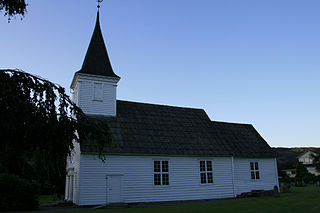
Gjerde Church is a parish church of the Church of Norway in Etne Municipality in Vestland county, Norway. It is located in the Etnesjøen, just south of the village centre. It is one of the churches for the Etne parish which is part of the Sunnhordland prosti (deanery) in the Diocese of Bjørgvin. The white, wooden church was built in a long church design in 1676 using plans drawn up by an unknown architect. The church seats about 250 people.





